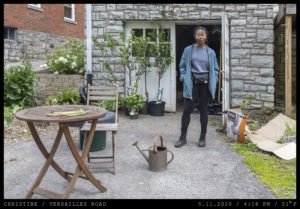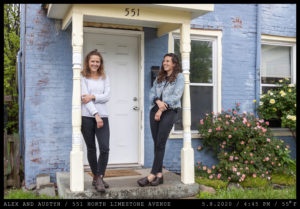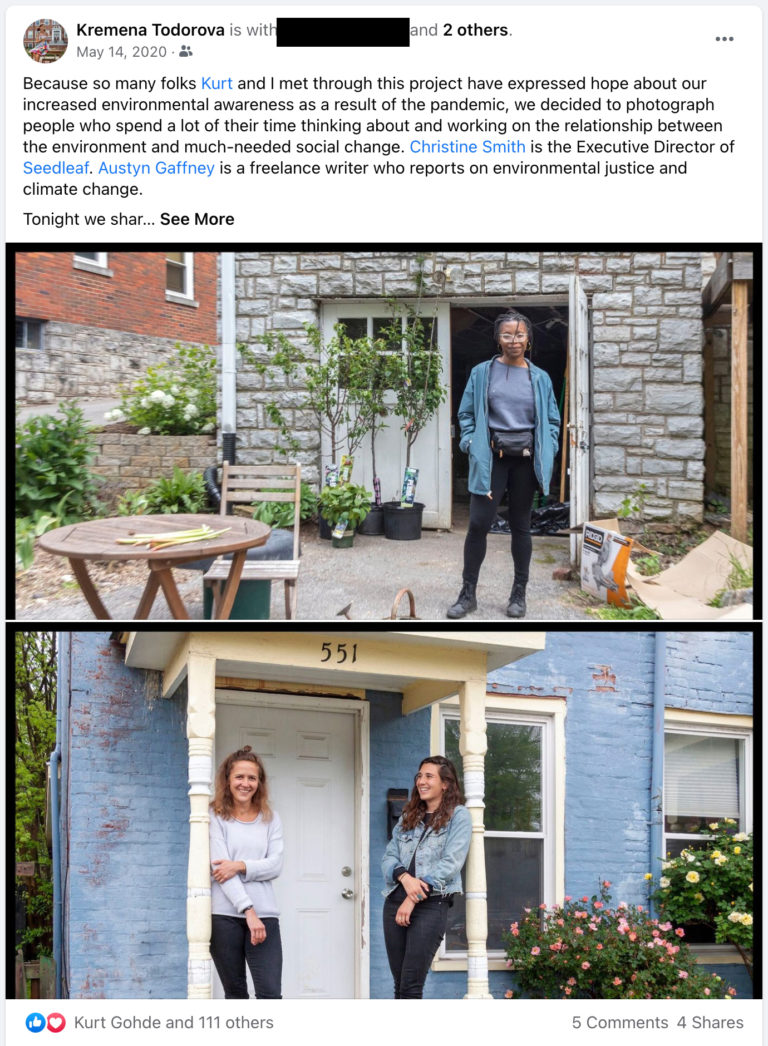Because so many folks Kurt and I met through this project have expressed hope about our increased environmental awareness as a result of the pandemic, we decided to photograph people who spend a lot of their time thinking about and working on the relationship between the environment and much-needed social change. Christine Smith is the Executive Director of Seedleaf. Austyn Gaffney is a freelance writer who reports on environmental justice and climate change.
Tonight we share Austyn’s reflection about peonies, global crises, and falling in love with the world outside.
Austyn: “During the pandemic, walks define our days. Alex and I both write from home, but we’ve turned neighborhood strolls into rituals: before we sit down at our desks, a mid-afternoon break, an evening shake out.
And because quarantine aligns with spring it brings new lessons: we’re learning the names of trees and we’ve found our favorite gardens. We watch blooms overlap each other: how the blush of willows and magnolias lead to the redbuds and the dogwoods and the tulip poplars, then overtaken by the oaks and gingkoes and maples. The early yellow of forsythia and daffodils turns to tulips, irises, peonies. We pick up the split ovals of robin’s eggs in the park, watch the cardinals fighting in a tree, observe the snakes that wrap around each other on fence posts, and gather the skins they leave behind in the wood pile. Months pass and we see new foals gain confidence on their rickety legs and sprout tufts of fur along their spines.
I keep my scope small. I pay attention to the world within a couple miles of Alex’s front porch. We’ve started home improvement projects; we built her first raised bed two weeks ago. We water the starts of lettuce and kale, broccoli and squash, and we speak tenderly to the tomatoes. On Friday night, Alex went outside near midnight in a parka and big boots to cover the bed with a tarp before a freak freeze. The next day, we went to pick up my CSA from the farmer’s market, and we chatted through our masks about how their own crop had fared the night before. It’s a small thing, but we were more in tune to the erratic weather.
More and more, I find myself paralleling coronavirus with climate change. Both are global crises. Both require governmental preparedness and action along with transformative social change. But unlike COVID-19, climate change has been ever-present for decades: the spring floods that drown our crops and trap Kentuckians in their homes, the summer heat waves and electricity blackouts, the outbreaks of pests in our forests and the high rates of asthma in our cities. And it impacts everyone, though just like COVID-19, the most vulnerable are defined by race, class, and geography.
The questions of coronavirus–how do I change my daily habits to best protect my neighbors?–are the same questions human-caused climate change asks of us. How can a string of small changes do less harm and lead to a different sort of life?
I wonder if this pause could allow us to reevaluate our membership in the ecological webs that nurture us. The pause could help us fall in love with the world outside our walls again. It’s only through such attention, care, and devotion that we can make the drastic and immediate changes necessary to mitigate our other catastrophe.
Though I spend a majority of my time quarantined with Alex, we have the luxury of giving each other space: I sometimes return to my own apartment in Louisville. On Sunday night she called me while I was trying to write something slightly hopeful about coronavirus, without being able to get out of the shadow of ecological collapse.
Over the phone wires, Alex said she’d just taken a video of a tree across the street from her porch. The tree was swaying in the breeze and its leaves were illuminated in late evening. A few minutes later, she said, the light was gone. She’d caught it minutes before the sun passed.
But what if she hadn’t gone outside?
What if none of us had really seen our world before it left?”
#TogetherKY #TeamKentucky #HealthyAtHome

Christine
05.11.2020
2:52 PM
Christine Smith, Executive Director of Seedleaf, a community gardening organization in Lexington,

Alex and Austyn
05.08.2020
4:02 PM
Austyn: “During the pandemic, walks define our days. Alex and I both

